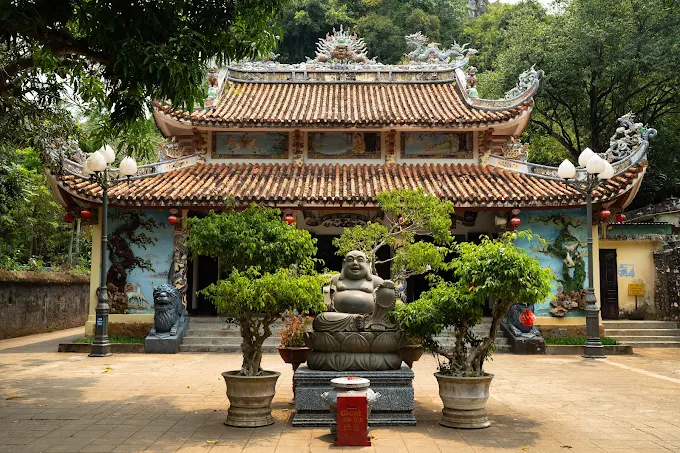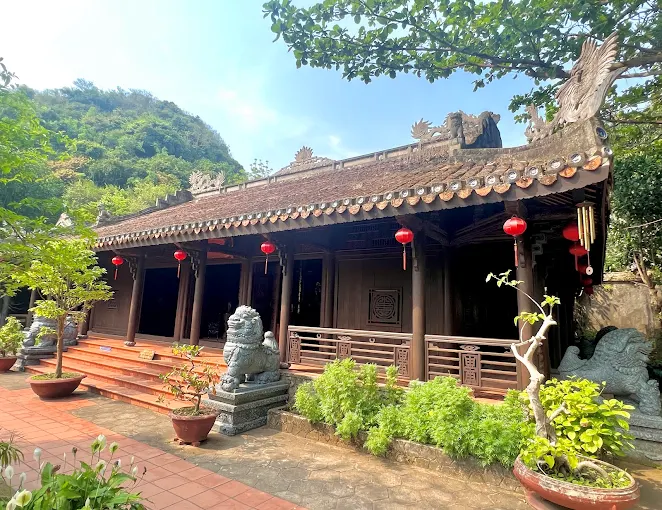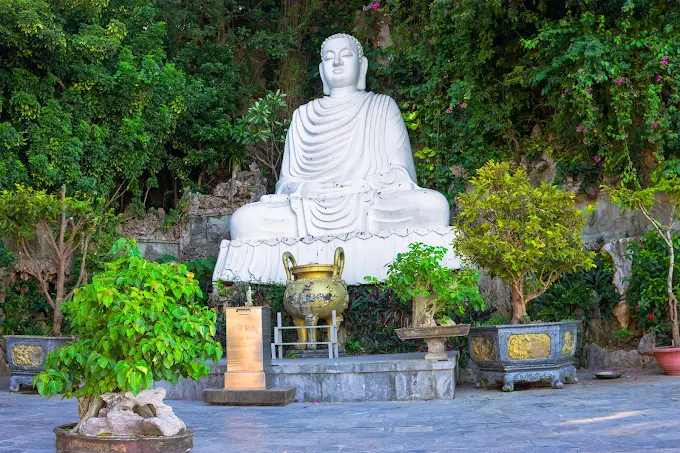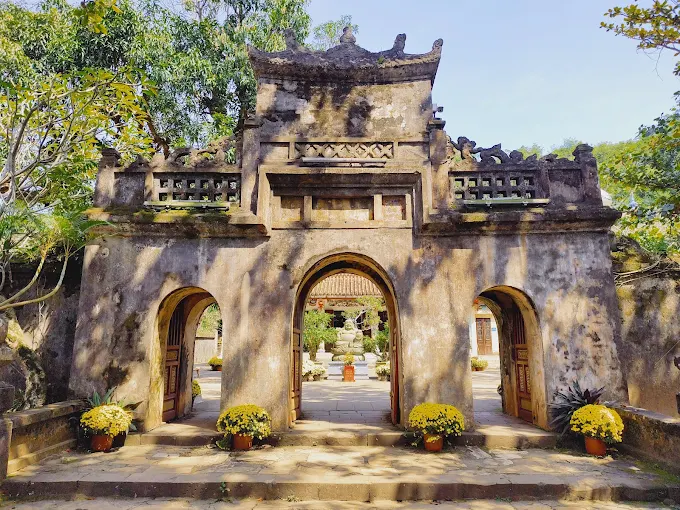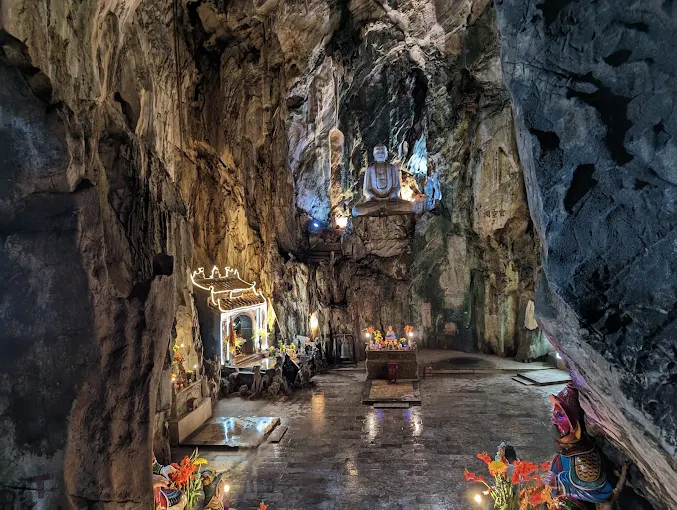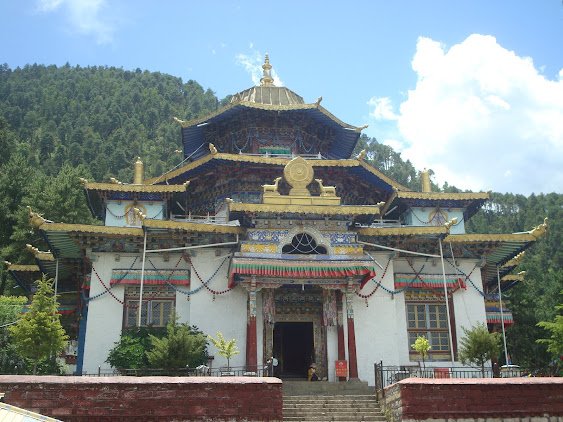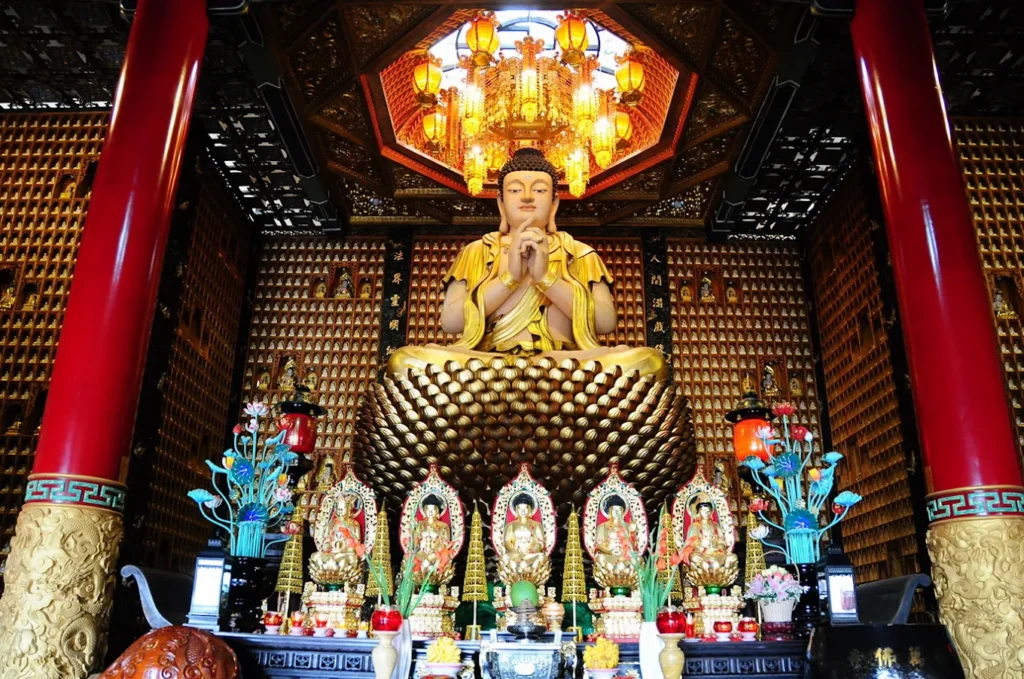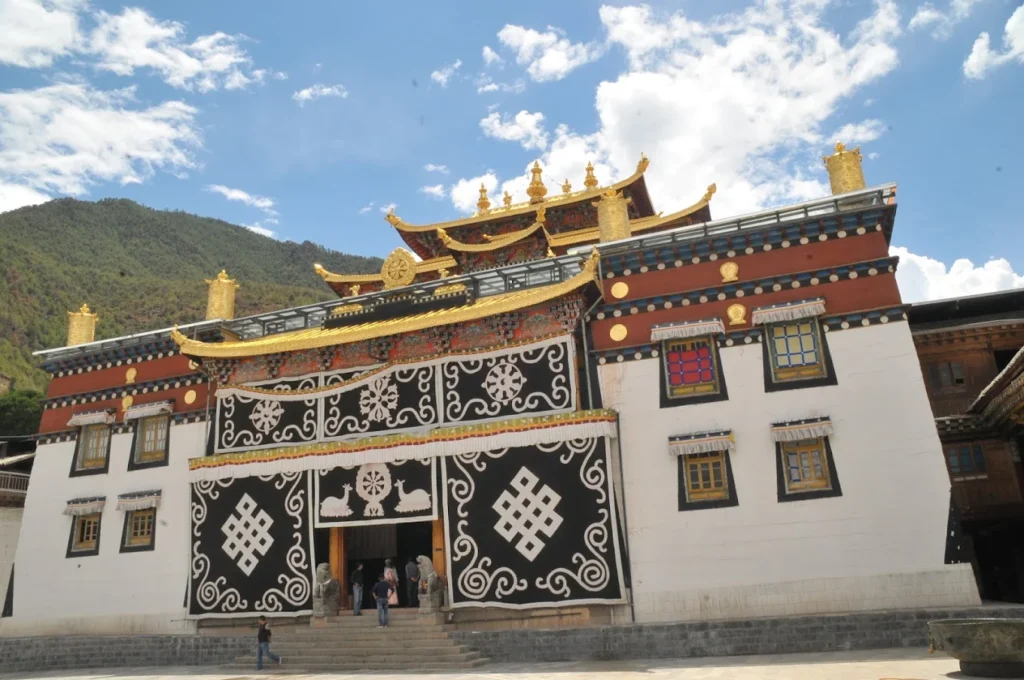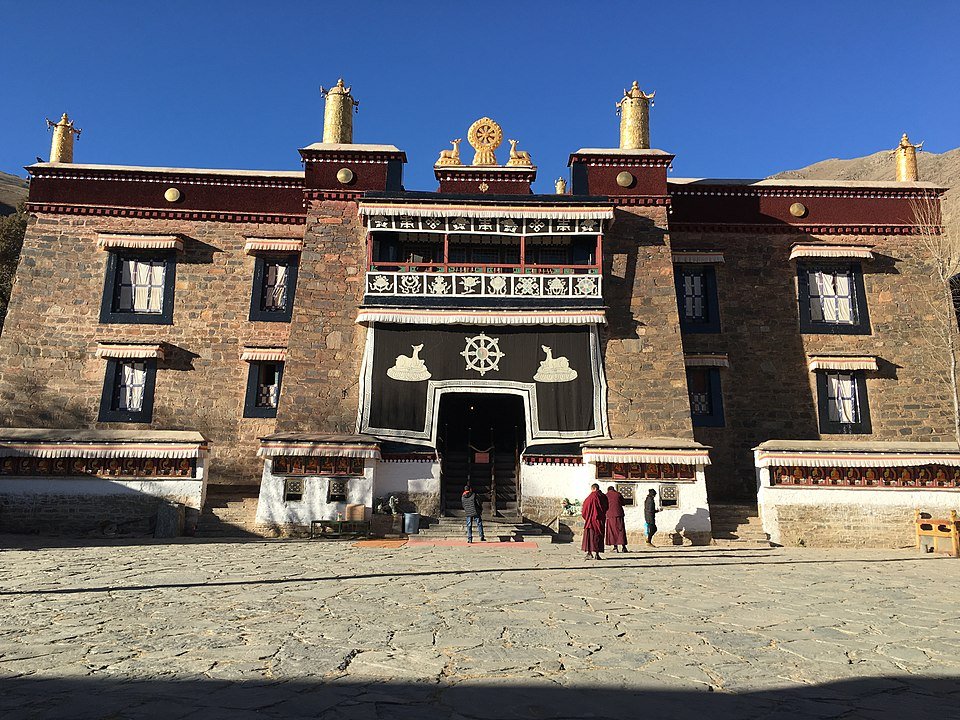Tam Thai Pagoda: The Timeless Sanctuary of Mahayana Grace
As dawn casts a golden veil over Đà Nẵng’s Marble Mountains, Tam Thai Pagoda on Thuy Son awakens, its ancient main hall cradled by limestone peaks, where the serene Buddhas of Three Times radiate eternal wisdom. The air hums with Amitabha chanting, devotees seeking rebirth in Amitabha’s Western Paradise, their voices mingling with sandalwood incense and the rustle of bodhi leaves. A lotus bloom sways in the courtyard’s tranquil pond, reflecting the pagoda’s dragon-crowned roof, a masterpiece of Vietnamese artistry. This Mahayana sanctuary, steeped in Nguyen Dynasty lore, invites all to immerse in Vietnam’s enduring Buddhist heritage.
Overview and Significance
Introduction to Tam Thai Pagoda
Tam Thai Pagoda, perched on Thuy Son (Water Mountain) in Đà Nẵng’s Marble Mountains, stands as a historic Mahayana Buddhist temple, its revered Buddhas of Three Times and Avalokitesvara statues embodying the grace of the Pure Land tradition, which centers on devotion to Amitabha Buddha for rebirth in his Western Paradise. Located 10 kilometers from the city center within the UNESCO-listed Marble Mountains, this 19th-century gem blends East Asian elegance with Vietnamese Nguyen Dynasty architectural designs. Its compact main hall, serene courtyard, and legendary link to a miraculous water source make it a cultural treasure, drawing pilgrims, historians, and adventurers into a realm of timeless spirituality.
Historical Journey
Tam Thai Pagoda traces its origins to the early 19th century during the Nguyen Dynasty, founded under King Gia Long’s reign and rebuilt in 1825 by King Minh Mang to honor Thuy Son’s sacred waters. Legend holds that Nguyen Anh (later King Gia Long) vowed to build the temple after a miraculous water source saved him during his campaigns, cementing its spiritual significance. Community donations sustained its growth, with renovations in the 20th century preserving its Nguyen Dynasty charm.
Through centuries of change, the pagoda has remained a spiritual haven, its history reflecting Đà Nẵng’s blend of royal legacy and Buddhist devotion.
- Patronage: Supported by local Mahayana Buddhists and Nguyen Dynasty rulers.
- Milestones: Founded in early 19th century; rebuilt in 1825; renovated in 20th century.
Cultural Significance
Tam Thai Pagoda is a vital hub for Đà Nẵng’s Mahayana community, nurturing devotion to the Buddhas of Three Times and Avalokitesvara. Its Pure Land practices, centered on Amitabha chanting, offer solace to devotees and artisans of the nearby Non Nuoc stone carving village. The pagoda hosts cultural events, like Vesak celebrations and lunar festivals, drawing crowds to its sacred grounds.
Regionally, it connects with Mahayana communities in Vietnam, sharing Pure Land teachings. Globally, it attracts scholars studying Nguyen Dynasty architecture and pilgrims drawn to its Marble Mountains setting, offering a glimpse into Mahayana’s compassion.
- Mahayana Hub: Preserves Pure Land practices in Đà Nẵng.
- Cultural Role: Hosts Vesak and lunar festivals.
- Global Appeal: Attracts scholars and pilgrims for its historic setting.
Unique Legacy
The pagoda’s ancient main hall and Buddhas of Three Times statues define its legacy, embodying Mahayana’s timeless grace. The main hall’s dragon motifs and the statues’ serene presence symbolize enlightenment’s continuity. Vietnamese lotus carvings and stonework reflect Nguyen Dynasty syncretism, while Avalokitesvara’s statue anchors spiritual devotion.
This fusion of historic architecture, spiritual statues, and legendary lore earns Tam Thai Pagoda its title as the “Timeless Sanctuary of Mahayana Grace,” an enduring beacon of faith.
- Main Hall: Historic structure with dragon motifs.
- Sacred Statues: Buddhas of Three Times as spiritual anchors.
- Cultural Syncretism: Vietnamese Nguyen Dynasty influences.
Community and Global Impact
Tam Thai Pagoda thrives as a communal heart for Đà Nẵng’s Buddhist community. On lunar days, devotees gather before the Buddhas of Three Times to chant and offer incense, their prayers echoing through the mountains. Charity drives, supporting Non Nuoc artisans, strengthen local bonds, while Vesak festivals draw crowds with lantern processions and offerings to Avalokitesvara.
Globally, the pagoda hosts Buddhist exchanges, welcoming Vietnamese monks and scholars. The Vietnamese diaspora supports preservation efforts, reinforcing cultural ties. Its historic setting and spiritual statues cement its global role as a Mahayana sanctuary.
- Local Engagement: Hosts prayers, charity, and festivals.
- Global Reach: Draws monks and scholars from Vietnam.
- Diaspora Support: Funded by Vietnamese communities abroad.
Architectural and Spiritual Features
Iconic Design
Tam Thai Pagoda’s architecture blends Mahayana heritage with Vietnamese Nguyen Dynasty elegance, its compact main hall nestled on Thuy Son’s limestone peak within the 15-hectare Marble Mountains. The layout centers on the main hall, courtyard, and small meditation pavilion, framed by bodhi trees. Its muted palette—gold, red, and stone gray—evokes Mahayana’s eternal calm, with Vietnamese dragon-crowned roofs and lotus motifs harmonizing with the mountain’s rugged beauty.
The main hall’s intricate stonework and the courtyard’s serene simplicity, rooted in Nguyen Dynasty traditions, craft a sacred oasis of devotion and awe.
- Main Hall: Compact structure with dragon motifs.
- Vietnamese Aesthetic: Tiled roofs and lotus motifs.
- Mountain Oasis: Harmonizes with Marble Mountains.
Key Structures
The main hall, housing revered statues, is the pagoda’s spiritual heart, its ornate altars glowing under soft light. The courtyard, with a lotus pond and bodhi trees, serves as a communal space for festivals. A small meditation pavilion, adorned with ceramic tiles, offers quiet reflection. Nearby cave shrines, like Ngu Coc, house additional statues, while the 108 stone steps to Vong Giang Dai offer river views.
These structures, blending spiritual and natural beauty, create a serene Mahayana sanctuary.
- Main Hall: Spiritual heart with revered statues.
- Courtyard: Communal space with lotus pond.
- Meditation Pavilion: Compact retreat for reflection.
Worshipped Statues
The main hall’s Buddhas of Three Times statues—representing Dipankara (past), Shakyamuni (present), and Maitreya (future)—stand gilded on lotus pedestals, symbolizing enlightenment’s continuity. Avalokitesvara, crafted in white porcelain with a nectar vase, offers compassion. Smaller cave shrines house Ksitigarbha (Địa Tạng [地藏]), in jade with a staff, guiding souls from suffering, and Samantabhadra, in stone, embodying virtue.
These statues, central to Mahayana worship, embody the pagoda’s spiritual essence, their iconography fostering devotion.
- Buddhas of Three Times: Gilded, symbolizing past, present, future.
- Avalokitesvara: Porcelain, offering compassion.
- Ksitigarbha: Jade, guiding souls from suffering.
Materials and Techniques
The main hall, crafted with marble and ceramic tiles, showcases Vietnamese artisans’ mastery, its dragon motifs reflecting Nguyen Dynasty symbolism. The statues, gilded and carved with lotus motifs, use teak woodwork rooted in local traditions. Stone carvings of Buddhist tales adorn the courtyard, blending Vietnamese craftsmanship with Mahayana iconography. The tiled roof, with red patterns, adds durability and elegance, a hallmark of 19th-century Vietnamese architecture.
These materials, grounded in Vietnamese syncretism, create a visually striking and spiritually resonant sanctuary.
- Marble Hall: Ceramic-tiled main hall with dragon motifs.
- Gilded Statues: Teak woodwork with lotus carvings.
- Stone Carvings: Vietnamese Buddhist tales.
Signature Elements
The main hall and Buddhas of Three Times statues are the pagoda’s signature elements, their timeless grace symbolizing Mahayana devotion. The hall’s dragon-crowned roof, glowing under festival lights, and the statues’ golden serenity anchor worship. Vietnamese altars, with red and gold carvings, frame the statues, enhancing their spiritual presence.
These elements, blending architectural splendor and spiritual devotion, define Tam Thai Pagoda’s Mahayana identity, captivating all who visit.
- Main Hall: Dragon-crowned structure.
- Buddhas of Three Times: Golden anchors of devotion.
- Vietnamese Altars: Vibrant frames for statue worship.
Lesser-Known Features
The main hall’s ceiling, painted with lotus murals, forms a meditative canopy, often unnoticed in soft light. The courtyard’s stone lanterns, inspired by Vietnamese designs, cast gentle glows at dusk. Cave shrines house ceramic sutra tablets, offering spiritual insight. A small koi pond near the entrance, with lotus blooms, adds serene beauty, reflecting the pagoda’s tranquil depth.
These subtle details enrich Tam Thai’s spiritual allure, rewarding attentive visitors.
- Lotus Murals: Meditative ceiling in the main hall.
- Stone Lanterns: Vietnamese-style courtyard glow.
- Koi Pond: Serene entrance feature.
Preservation and Evolution
The pagoda’s marble structures withstand Đà Nẵng’s humidity, but the roof’s tiles require periodic cleaning by artisans. Volunteers maintain the courtyard, cave shrines, and statue altars. 20th-century renovations preserved the Nguyen Dynasty design, while adding the meditation pavilion to enhance accessibility.
These efforts ensure Tam Thai Pagoda remains a vibrant Mahayana temple, balancing tradition with modernity.
- Maintenance: Periodic tile cleaning.
- Modern Updates: Meditation pavilion added in 20th century.
Rituals and Practices
Daily Sacred Rites
Each morning, Tam Thai Pagoda resonates with Amitabha chanting, led by monks before the Buddhas of Three Times, invoking rebirth in the Western Paradise. Devotees offer incense at the incense house, their prayers rising before Avalokitesvara’s compassionate gaze. The meditation pavilion’s bell tolls, grounding worshippers in devotion.
Lay followers present lotus flowers and candles to Bodhisattva statues, bowing in reverence. The cave shrines invite sutra recitation, fostering Mahayana’s universal salvation.
- Morning Chanting: Amitabha chanting before statues.
- Incense Offerings: Prayers for rebirth in the Pure Land.
- Sutra Recitation: Quiet cave shrine devotion.
Unique Practices
The pagoda’s Pure Land devotion centers on Amitabha chanting, guiding devotees toward rebirth in the Western Paradise. Monks lead daily sessions before the Avalokitesvara statue, cultivating mindfulness. Vegetarian offerings, placed in ornate bowls before the Buddhas of Three Times, emphasize merit-making, reflecting Vietnamese Mahayana traditions.
On full-moon days, monks perform water-blessing ceremonies, unique to Tam Thai’s link to Thuy Son’s sacred springs, honoring the Nguyen Anh legend and blessing artisans of Non Nuoc village.
- Pure Land Chanting: Daily Amitabha sessions.
- Vegetarian Offerings: Merit-making before statues.
- Water-Blessing Ceremonies: Full-moon rituals tied to sacred springs.
Festival Traditions
Vesak, celebrating Buddha’s birth, enlightenment, and passing, transforms Tam Thai with lantern processions illuminating the courtyard, devotees offering lotus flowers before Avalokitesvara. Vu Lan, honoring filial piety, draws crowds pinning roses—red for living parents, white for the deceased—before the statues, as monks chant for ancestral liberation. Tet brings dragon dances and red envelope offerings, blending Mahayana devotion with Vietnamese festivity.
Lunar days attract pilgrims for special Amitabha chanting sessions, with statue veneration in cave shrines, uniting the community in reverence.
- Vesak: Lantern processions and offerings before Avalokitesvara.
- Vu Lan: Rose-pinning and chanting for ancestors.
- Lunar Days: Cave shrine chanting and veneration.
Visitor Engagement
Visitors can light incense or offer lotus flowers before Avalokitesvara at the incense house, guided by monks on Mahayana etiquette. Amitabha chanting sessions, open to all, allow participation in Pure Land practices. During Vesak, tourists may join lantern processions or offer roses before the statues, immersed in spiritual rituals.
The pagoda’s cave shrines foster cultural exchange, with monks sharing insights on statue worship, connecting locals and global visitors.
- Incense Lighting: Guided offerings before Avalokitesvara.
- Amitabha Chanting: Open Pure Land sessions.
- Festival Participation: Lantern processions during Vesak.
Spiritual Community Roles
Tam Thai’s monks, trained in Mahayana Pure Land teachings, lead chanting sessions and mentor devotees. They organize charity drives, supporting Non Nuoc artisans, strengthening community ties. Lay volunteers maintain statue altars and cave shrines, fostering a sense of unity.
The abbot delivers sermons on compassion before Avalokitesvara, guiding initiatives. Buddhist devotee groups (Phật tử) organize Vesak and Vu Lan events, enriching communal life.
- Monks: Lead rituals, mentor, and organize charity.
- Lay Volunteers: Maintain statue altars and cave shrines.
- Buddhist Devotees: Organize Vesak and Vu Lan celebrations.
Visitor Information
Navigating to Tam Thai Pagoda
Tam Thai Pagoda is located on Thuy Son, Marble Mountains, Khối Hà, Ngũ Hành Sơn District, Đà Nẵng, its dragon-crowned main hall a landmark amidst limestone peaks. The nearby Non Nuoc Beach, a 5-minute drive, offers scenic views, while Đà Nẵng’s city center, with landmarks like the Dragon Bridge, is a 15-minute taxi ride. The pagoda blends natural splendor with urban accessibility.
From the city center, visitors can take a taxi or motorbike via Trường Sa and Lê Văn Hiến roads, reaching the Marble Mountains’ base, then ascend 108 stone steps or use an elevator (fee: ~15,000 VND) to Thuy Son.
- Landmark: Main hall on Thuy Son, Marble Mountains.
- Nearby Sites: Non Nuoc Beach (2 km), Dragon Bridge (8 km).
- Central Access: 15-minute taxi from city center.
Address of Tam Thai Pagoda
- Vietnamese: Chùa Tam Thai, Núi Thủy Sơn, Ngũ Hành Sơn, Khối Hà, Quận Ngũ Hành Sơn, Thành phố Đà Nẵng, Việt Nam.
- English: Tam Thai Pagoda, Thuy Son Mountain, Marble Mountains, Khối Hà, Ngũ Hành Sơn District, Đà Nẵng City, Vietnam.
Visiting Hours and Etiquette
Tam Thai Pagoda is open daily from 7:00 AM to 5:00 PM, with early mornings offering a peaceful setting for chanting before the statues. The main hall and meditation pavilion are accessible daily, with guided cave tours during festivals like Vesak. Visitors should plan 1–2 hours to explore the pagoda, caves, and viewpoints.
Dress modestly, covering shoulders and knees, and remove shoes before entering the main hall or cave shrines. Photography is permitted in the courtyard but requires permission inside shrines. Bow three times before statues to show respect, adhering to Mahayana customs.
- Hours: 7:00 AM–5:00 PM daily.
- Access: Main hall and pavilion open daily; guided during festivals.
- Etiquette: Modest dress, remove shoes, bow before statues.
Accessibility and Safety
The pagoda offers an elevator to Thuy Son’s base for ~15,000 VND, but 108 stone steps to the main hall may challenge mobility-impaired guests; a slower path with fewer steps is available. The courtyard’s flat surfaces suit wheelchairs, though cave shrines have uneven terrain. Volunteers assist during festivals, guiding visitors to statue altars.
Ngũ Hành Sơn is safe, but mountain paths can be slippery—wear sturdy shoes. Stay on designated trails to avoid steep slopes, and bring water for Đà Nẵng’s humidity.
- Accessibility: Elevator to base; steps to main hall.
- Safety: Wear sturdy shoes; stay on trails.
- Assistance: Volunteers available during festivals.
Amenities and Surroundings
Tam Thai Pagoda provides restrooms, drinking water, and shaded benches in the courtyard. A kiosk sells incense and lotus flowers for statue offerings, supporting maintenance. The lotus pond and bodhi trees create tranquil spots, enhancing the spiritual ambiance.
Non Nuoc Village, at the Marble Mountains’ base, offers stone carving shops and seafood stalls, while Non Nuoc Beach, a 5-minute drive, provides dining and relaxation, enriching the cultural experience.
- Amenities: Restrooms, water, incense kiosk.
- Surroundings: Non Nuoc Village, Non Nuoc Beach (2 km).
- Sensory Highlights: Mountain breezes, incense, cave echoes.
Immersive Visitor Tips
Arrive at 7:00 AM to join Amitabha chanting before the Buddhas of Three Times, fostering mindfulness. During Vesak, offer a lotus flower before Avalokitesvara and join a lantern procession, immersing in spiritual unity. Photograph the main hall at sunrise, its dragon roof glowing against the mountains, but avoid flash in shrines.
Explore nearby Ngu Coc Cave or Vong Giang Dai for river views, or visit Non Nuoc Village for stone souvenirs. Visit on lunar days for water-blessing ceremonies and statue veneration, deepening your connection.
- Morning Chanting: Join Amitabha sessions early.
- Sunrise Photography: Capture the main hall’s glow.
- Festival Immersion: Offer lotuses during Vesak.
